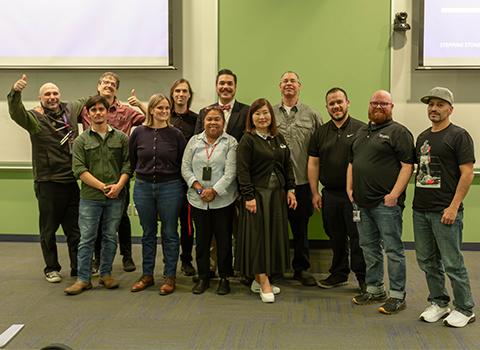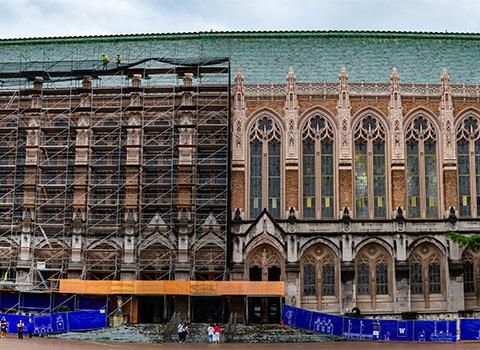Power Plant upgrades lead to decarbonization gains

This boiler in the UW Power Plant was modified to produce lower-pressure steam for heating campus. The upgrade project has resulted in greater resiliency and a reduction in greenhouse gas emissions. Mark Kirschenbaum
Decarbonizing UW operations is a big job that involves rebuilding the campus energy infrastructure, and it will take nearly a decade to complete. But it just got a boost from an unexpected source.
Right now, the UW burns natural gas to create steam and heat campus, emitting greenhouse gases. The University is at the beginning of an effort to decarbonize its energy system, called the Energy Transformation Strategy.
At the UW Power Plant, boilers are the machinery used to burn the natural gas. The UW recently standardized all its boilers so that they all produce steam at the same pressure. One of the outcomes of that effort was an efficiency gain that has led to a significant reduction in greenhouse gas emissions.
David Woodson, executive director of the Campus Energy, Utilities & Operations department, explained the significance of the boiler upgrades and gave an update on the overall work to decarbonize the UW.
For help with terminology, please roll over highlighted terms below or browse our Energy Transformation glossary. This interview has been edited for length and clarity.
Tell me about the boiler upgrades and how they have helped advance the decarbonization effort.
There are five boilers in the Power Plant, and they’re all various vintages. The two newest ones are from 2000 and 1994, and then the oldest ones are 1948 and 1958. It used to be that they produced different-pressure steam. The boilers from 2000 and 1968 produced high-pressure steam, and the others produced a lower-pressure steam. And as a result, if the newest one was out of service, the only one that could operate at that high pressure was the boiler from 1968. What we did was modify the boilers so that they're all at the same pressure.
Now, there's less dependency on the older boilers, and the effect of that is that if one or two were out of service, you can still provide all the steam the campus needed from the remaining boilers. So that was the big driver — to ensure that we could provide steam to critical areas of the campus like the hospital, especially knowing what we're about to embark on over the next 10 years [as we decarbonize].
But one of the measurable impacts of that change was that we saw an over 10,000-ton reduction in greenhouse gas emissions from the plant. We knew there was going to be an improvement, but we thought it would be like 4% or 5% [of the plant’s total carbon footprint]. So we were very pleasantly surprised to see the results. To put that in context, the Power Plant itself emits just over 85,000 tons of carbon per year. So a 10,000-ton reduction gets us to 75,000 and change. That's a 12% overall reduction in our carbon footprint.
The boilers burn natural gas to create steam to heat campus. We’re moving to a heat pump system that will use electricity instead. How will those boilers be used after the move to electricity?
Even in the transition period, there's a role for steam. The hospital and some research spaces use steam for some of their processes, and whether that's sterilizers or autoclaves or cage washers, there needs to be a pivot there. Also, for redundancy, on the really cold days when it’s 10 degrees out, it would be nice to have that sort of backup to rely on. The steam boilers can help us on those really cool days, because there's definitely a concern on the pricing and availability of electricity on a cold day.
What is the status of the overall decarbonization effort, which we’ve been calling the Energy Transformation Strategy?
We’ve been diligently making efforts to transition our existing energy strategy to a very specific implementation plan. What are the projects that we're going to do over the next 10 years? What's the order of those projects? Which ones can be connected together and delivered in the same way? Which ones can be funded from federal and/or state grants, and which ones will we need to finance ourselves? We've hired a company called Affiliated Engineers, and they are working with a team of partners to develop the implementation plan.
A couple really interesting things have come out of that process already. What we've learned in initial modeling is that between the waste heat from the campus cooling system and the waste heat from the adjacent King County sewer lines, we can displace over 70% of the natural gas presently used to produced steam. We knew there was no one silver bullet that did everything and we needed a combination of pieces, but it’s kind of exciting that two of these pieces by themselves get us over 70% — and to think it’s from heat that is presently just discarded.
When will we see the plan?
It should be complete by the beginning of October.
What is on the list of the first projects that are part of the plan?
For example, the first two networks of hot water piping in the West Campus and the south of Pacific area and adding heat recovery chillers at West Campus [Utility Plant] to become the heating equipment for those first two networks. In order to do the connection to the sewer [to recover waste heat for heating campus], we now know where that connection would happen, and we want to run hot water pipes to that location.
Another one is the large cooling storage tank or thermal storage tank. That's a no-brainer efficiency play, and it gives us another tool that helps with resiliency. [Separately, we also want] to initiate efforts for the electrical improvements that we would have to do to receive additional electrical capacity from Seattle City Light. There are also a couple of design-type things, like doing a design standard for the overall work.
So those are the big projects, but there are a couple of other smaller projects. With the sewer connection, King County has announced a program to do three pilot projects for wastewater energy transfer connected to their system. They have asked whoever's interested in doing a pilot to take it to a 30% design stage as part of the application process. We are taking steps to get the work complete so that UW can be one of the pilot partners.



